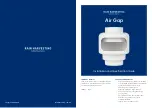
• Make sure that passwords are protected and only disclosed to authorized personnel.
• Do not use the same passwords for multiple user names and systems.
• Store the passwords in a safe location (not online) to have them available if they are lost.
• Regularly change your passwords to increase security.
• A password must be changed if it is known or suspected to be known by unauthorized
persons.
• When user authentication is performed via RADIUS, make sure that all communication takes
place within the security environment or is protected by a secure channel.
• Watch out for link layer protocols that do not offer their own authentication between
endpoints, such as ARP or IPv4. An attacker could use vulnerabilities in these protocols to
attack hosts, switches and routers connected to your layer 2 network, for example, through
manipulation (poisoning) of the ARP caches of systems in the subnet and subsequent
interception of the data traffic. Appropriate security measures must be taken for non-secure
layer 2 protocols to prevent unauthorized access to the network. Physical access to the local
network can be secured or secure, higher layer protocols can be used, among other things.
Certificates and keys
• There is a pre-installed Web server certificate (RSA, 2048 bit key length) and an SSH Private
Key in the device. Replace this certificate with a user-generated, high-quality certificate with
key. Use a certificate signed by a reliable external or internal certification authority. You can
install the certificate in the WBM via "System > Load and Save".
• Use the certification authority including key revocation and management to sign the
certificates.
• Use password-protected certificates in the format "PKCS #12".
• Use certificates with a key length of 4096 bits.
• Make sure that user-defined private keys are protected and inaccessible to unauthorized
persons.
• If there is a suspected security violation, change all certificates and keys immediately.
• SSH and SSL keys are available for admin users. Make sure that you take appropriate security
measures when shipping the device outside of the trusted environment:
– Replace the SSH and SSL keys with disposable keys prior to shipping.
– Decommission the existing SSH and SSL keys. Create and program new keys when the
device is returned.
• Verify certificates based on the fingerprint on the server and client side to prevent "man in the
middle" attacks. Use a second, secure transmission path for this.
• Before sending the device to Siemens for repair, replace the current certificates and keys with
temporary disposable certificates and keys, which can be destroyed when the device is
returned.
Security recommendations
SCALANCE M826
12
Operating Instructions, 10/2022, C79000-G8976-C362-07
Содержание SCALANCE M812
Страница 10: ...Safety notices SCALANCE M826 10 Operating Instructions 10 2022 C79000 G8976 C362 07 ...
Страница 30: ...Description of the device 3 8 PLUG SCALANCE M826 30 Operating Instructions 10 2022 C79000 G8976 C362 07 ...
Страница 56: ...Connecting up 5 7 Replacing the PLUG SCALANCE M826 56 Operating Instructions 10 2022 C79000 G8976 C362 07 ...
Страница 58: ...Maintenance and cleaning SCALANCE M826 58 Operating Instructions 10 2022 C79000 G8976 C362 07 ...
Страница 62: ...Technical specifications SCALANCE M826 62 Operating Instructions 10 2022 C79000 G8976 C362 07 ...
Страница 64: ... Figure 8 2 Side view Dimension drawings SCALANCE M826 64 Operating Instructions 10 2022 C79000 G8976 C362 07 ...
Страница 74: ...W Wall mounting 35 Wiring 24 Index SCALANCE M826 74 Operating Instructions 10 2022 C79000 G8976 C362 07 ...













































